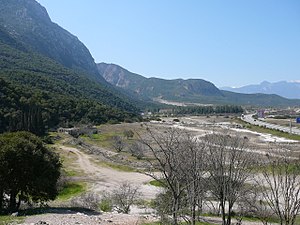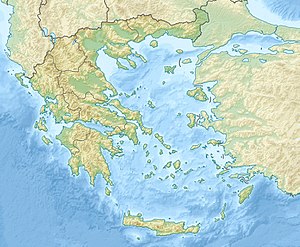The Battle of Thermopylae
| Battle of Thermopylae | |||||||||
|---|---|---|---|---|---|---|---|---|---|
| Part of the Greco-Persian Wars | |||||||||
 The site of the battle today. Mount Kallidromon on the left, and the wide coastal plain formed by accretion of fluvial deposits over the centuries; the road to the right approximates the 480 BC shoreline. |
|||||||||
|
|||||||||
| Belligerents | |||||||||
| Greek city-states | Persian Empire | ||||||||
| Commanders and leaders | |||||||||
| King Leonidas I † Demophilus † |
King Xerxes I of Persia Mardonius Hydarnes II |
||||||||
| Strength | |||||||||
| Total 5,200 (or 6100) + the Locrians (Herodotus) 7,400+ (Diodorus) 11,200 (Pausanias) 7,000 (modern est.) |
2,124,000 (Herodotus) 60,000–300,000 (modern est.) |
||||||||
| Casualties and losses | |||||||||
| 4,000 (Herodotus) | ~20,000 (Herodotus) | ||||||||
|
|
|||||||||
Coordinates: 38°47′47.8″N 22°32′12.2″E / 38.796611°N 22.536722°E
The Battle of Thermopylae (/θərˈmɒpᵻliː/ thər-MOP-i-lee; Greek: Μάχη τῶν Θερμοπυλῶν, Machē tōn Thermopylōn) was fought between an alliance of Greek city-states, led by King Leonidas of Sparta, and the Persian Empire of Xerxes I over the course of three days, during the second Persian invasion of Greece. It took place simultaneously with the naval battle at Artemisium, in August or September 480 BC, at the narrow coastal pass of Thermopylae ("The Hot Gates"). The Persian invasion was a delayed response to the defeat of the first Persian invasion of Greece, which had been ended by the Athenian victory at the Battle of Marathon in 490 BC. Xerxes had amassed a huge army and navy, and set out to conquer all of Greece. The Athenian general had proposed that the allied Greeks block the advance of the Persian army at the pass of Thermopylae, and simultaneously block the Persian navy at the Straits of Artemisium.
...
Wikipedia

